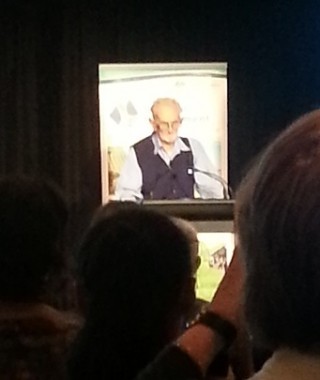James and I attended the state Natural Resource Management (NRM) conference (aka “The Tipping Point conference”) between May 7-9 in Busselton. It was a wet and windy couple of days in Busselton, but well worth our trip.
Thank goodness James was driving when we hit this front in Busselton
The Tipping Point Conference was a busy one for us. I gave an oral presentation and we also were there to help support the South West Catchments Council (SWCC) provide a poster on our Geographic & Reporting Information Database (GRID) system, and to also be sponsors at the event.
The conference was opened and the tone set quickly; Sue Middleton’s simple premise that “you are the carers” was one that resonated with me for the whole conference. This opening stream of the conference was one that really set a high bar; with presentations from Craig Davis (“Capitalism: It’s killing us”), Larissa Brown (“Young people and Tipping Points”), Tom Tolchard’s “Future Proof” talk, Luke Bowen’s overview of the live export industry and Danica Leys’ social media review were all very thought provoking. I particularly liked Craig’s talk (not just because he’s a Star Trek fan) with his use of some very thought provoking concepts from the Conscious Capitalism movement – and the use of the Chipotle Scarecrow ad (look it up!).
After lunch on the first day, James and I split up into the streamed sessions.
I was tied to the Technology driving Change session, where my own paper was to be presented on “Technology Trends and NRM”. I have been seeing a few different trends in the NRM space, but chose to focus on social media, mobile systems and online systems, and give a “what is it, why use it, what to take away from it” style talk on each of them. There were a few appreciative tweets under the #tpc14 hashtag (although that was also for The Players Championship golf tournament), and you can access my presentation below via Slideshare.
Also in my session, I saw John Silver and Mel Strang give an update on the Rangelands NRM strategy (an online strategy we’ve had a hand in), Peta Kelsey covering some farm practice changes in the Avon region, Renata Zelinova give an update on their spatial data portal for biodiversity, and Kylie Bishop provide an update on the use of mobile mapping tech within the South Coast NRM group (with a great call to arms that we need to look outside our own industry for inspiration). James attended a mix of talks, including several on stories of change (around marine debris, animal pest management and vegetation conservation), and then moving to the community engagement stream to hear about mesquite management in the Pilbara and a seedling selector app for revegetation in the Wheatbelt region.
I had to miss the afternoon sessions with some meetings with clients, but those diverse streams presented a really interesting range of presentations and take home messages from the first day, and left us looking forward to the second day.
Day two had two highlights for me; the talk on shale gas fracking by Dr Peter Stone from CSIRO, who talked through the differences between shale gas fracking and coal seam gas fracking. This was a good presentation as it focused on the science, which I knew nothing about in terms of any type of fracking. It certainly made me think about this very political topic in a different way.
Secondly, the conference was closed by Dr. Harry Butler, someone who is a very interesting speaker – not just because he speaks his mind, but also because he has a lot of experience to bring to the table. His talk had a focus on his work in Barrow Island, where he has worked on the one project for 51 years. He really did give a different view on the social, ecological and somewhat political aspects of natural resource management.
 Not often you get to hear from an icon like Dr. Harry Butler (even from this far away)
Not often you get to hear from an icon like Dr. Harry Butler (even from this far away)
In between these two highlights were a range of talks that James and I jumped around in – I saw talks on engagement in the Perth hills (including a brief plug on The Marri App we developed with EMRC), indigenous group work in the Rangelands, and forestry management. Meanwhile, James (with his background of being a “real farmer”, unlike my “small farmer” background) focused on the farming stream, seeing talks on soil acidity, nutrients, identifying high quality land, water use and a natural resource report card talk.
A few people asked me why we would sponsor the conference (although all were very happy that we did!). As most readers of this blog would know, we only do environmental work here at Gaia Resources. For us, the NRM organisations represent a very important part of our history – and I hope our future. So our sponsorship was aimed at one thing; to say thanks for all the support we’ve had from the NRM groups over the ten years we have been operating.
The Tipping Point Conference was definitely worth the trek – topped off when our families came down to join us for the weekend afterwards!
Piers
Leave me a comment below, start a conversation on the Gaia Resources Facebook page, or get in touch with me via Twitter.


Comments are closed.